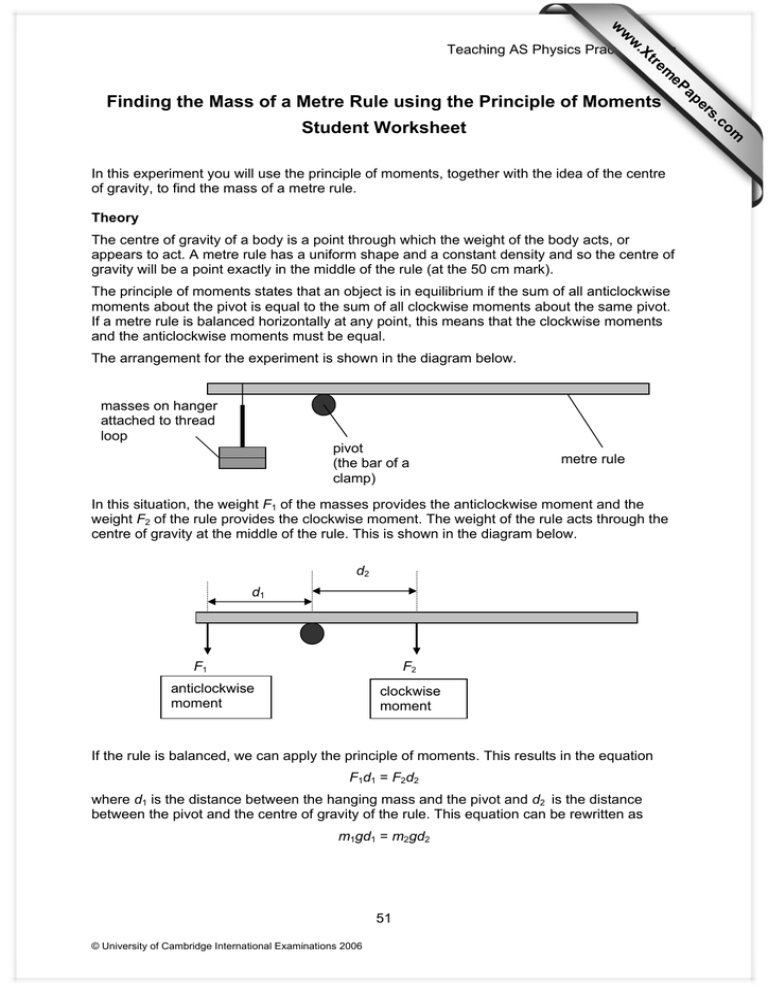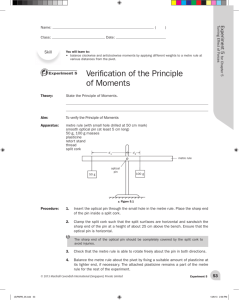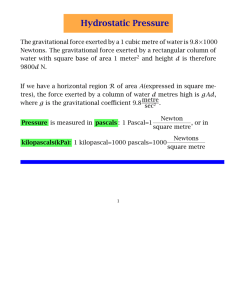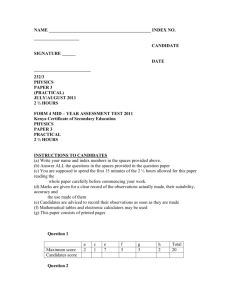Finding the Mass of a Metre Rule using the Principle... Student Worksheet www.XtremePapers.com
advertisement

w w w om .c Student Worksheet In this experiment you will use the principle of moments, together with the idea of the centre of gravity, to find the mass of a metre rule. Theory The centre of gravity of a body is a point through which the weight of the body acts, or appears to act. A metre rule has a uniform shape and a constant density and so the centre of gravity will be a point exactly in the middle of the rule (at the 50 cm mark). The principle of moments states that an object is in equilibrium if the sum of all anticlockwise moments about the pivot is equal to the sum of all clockwise moments about the same pivot. If a metre rule is balanced horizontally at any point, this means that the clockwise moments and the anticlockwise moments must be equal. The arrangement for the experiment is shown in the diagram below. masses on hanger attached to thread loop pivot (the bar of a clamp) metre rule In this situation, the weight F1 of the masses provides the anticlockwise moment and the weight F2 of the rule provides the clockwise moment. The weight of the rule acts through the centre of gravity at the middle of the rule. This is shown in the diagram below. d2 d1 F1 F2 anticlockwise moment clockwise moment If the rule is balanced, we can apply the principle of moments. This results in the equation F1d1 = F2d2 where d1 is the distance between the hanging mass and the pivot and d2 is the distance between the pivot and the centre of gravity of the rule. This equation can be rewritten as m1gd1 = m2gd2 51 © University of Cambridge International Examinations 2006 s er Finding the Mass of a Metre Rule using the Principle of Moments ap eP m e tr .X Teaching AS Physics Practical Skills Teaching AS Physics Practical Skills Principle of Moments Student Worksheet where m1 is the mass hanging from the rule, m2 is the mass of the metre rule and g is the acceleration of free fall. This can be rearranged to give m2 = m1 × (d1 / d2). Making measurements and observations 1 Set up the stand, boss and clamp so that the bar of the clamp is horizontal and its height above the bench is a few centimetres more than the length of the mass hanger. 2 Hook the thread loop over the zero end of the metre rule. 3 Hang the mass hanger from the bottom of the thread loop underneath the metre rule. 4 Slide the thread loop so that it is at the 1 cm mark of the metre rule. 5 Move the metre rule and the hanging masses so that the metre rule balances horizontally on the bar of the clamp stand. (This may be a bit fiddly, so be patient.) 6 When it is balanced, record m1, d1 and d2. 7 Repeat the experiment for six different values of m1. Recording and presenting your data 1 All your measurements should be recorded in a table of results. Your table of results should include a column for m2. 2 The values in the column for m2 should be calculated using the equation m2 = m1 × (d1 / d2). Analysing your data 1 Calculate the average of your values for the mass m2 of the metre rule. Evaluation 1 Estimate as to the actual uncertainty in each measurement you have taken. 2 Describe any steps you took to reduce experimental errors. 3 Describe any limitations or problems with the method used to find m2 in this experiment. 4 Suggest ways in which the accuracy of the measurements taken could be improved. 52 © University of Cambridge International Examinations 2006 Teaching AS Physics Practical Skills Finding the Mass of a Metre Rule using the Principle of Moments Teaching Notes Link to theory 5(i) 5(e) apply the principle of moments show an understanding that the weight of a body may be taken as acting at a single point known as its centre of gravity Key learning objectives • To show an application of the law of moments. • To use the idea of centre of gravity in a practical context. • To develop confidence in experiments that require delicate manipulative skills. Notes This practical activity does not require the use of a graph and can be used early in the course, before graphical skills have been taught and while students are gaining confidence in the manipulative skills. The purpose of this activity is to combine the idea of a centre of mass together with the principle of moments and to experimentally find the mass of a metre rule. Some students may not find it easy to balance the metre rule and will need encouragement. Balancing the rule is easier if the masses are only about 1 cm clear of the bench when the rule is horizontal. The activity is intended to be a confidence building exercise in manipulating equipment. Expected results The mass of a metre rule will vary considerably depending upon the material of manufacture. Commonly they tend to have a mass of around 100 g, but given the variation it is a good idea to know the mass before the students carry out the activity. Possible extension work More able candidates can be shown a diagram of the arrangement, without being given the student worksheet, and can be asked to find the mass of the metre rule without further instructions. This will begin to develop their planning skills. 53 © University of Cambridge International Examinations 2006 Teaching AS Physics Practical Skills Finding the Mass of a Metre Rule using the Principle of Moments Technical Notes Apparatus requirements 1 Stand, boss and clamp. The bar of the clamp needs to be long enough to balance a metre ruler on. 2 Meter rule. This should be quite stiff. Wooden metre rules are preferable as plastic ones can bend. 3 Loop of thread long enough to fit loosely around the metre rule. 4 10 g mass hanger and nine 10 g slotted masses. 54 © University of Cambridge International Examinations 2006



